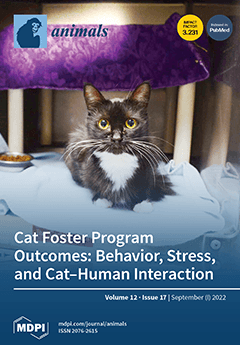Cardiopulmonary nematodes are highly pathogenic parasites affecting domestic and wild canids. As the result of conservation programs, the Iberian wolf (
Canis lupus signatus) population has recently expanded, and its distribution range covers lands from where it had long disappeared. However, the
[...] Read more.
Cardiopulmonary nematodes are highly pathogenic parasites affecting domestic and wild canids. As the result of conservation programs, the Iberian wolf (
Canis lupus signatus) population has recently expanded, and its distribution range covers lands from where it had long disappeared. However, the exact epidemiological role of the wolf in the life cycle of zoonotic parasites causing diseases transmissible to pets and/or humans is largely unknown. This study sought to determine the diversity of cardiopulmonary nematode parasite species that affect wolves inhabiting northwestern areas of the Iberian Peninsula, and to estimate their prevalence and the relationship between these parasites and several epidemiological variables. For this purpose, we examined the cardiopulmonary systems of 57 wolves from Galicia (from the provinces A Coruña
n = 15, Lugo
n = 21, Ourense
n =15 and Pontevedra
n = 6) using techniques of dissection and cup sedimentation. Collected worms were then identified under a light microscope according to their morphological features. Three species of nematodes were detected:
Angiostrongylus vasorum (the “French-heartworm”),
Crenosoma vulpis and
Eucoleus aerophilus, the latter being of zoonotic interest. The prevalence was 24.5% (14/57; 95% CI 13.3–35.6%) overall, 19.3% for
A. vasorum (11/57; 95% CI 8.8–29.2%), 7% for
C. vulpis (4/57; 95% CI 0.4–13.6%) and 3.5% for
E. aerophilus (2/57; CI −1.1–9.1%). A significant relationship (
p = 0.002) was found between age and the presence of
C. vulpis, which was only found in juvenile animals. Furthermore, a higher prevalence of
A. vasorum and/or
C. vulpis was observed in wolves with a lower body condition score (40% and 20%, respectively), though the difference was not significant (
p = 0.221 and
p = 0.444, respectively). Our findings indicate a high “French-heartworm” and lungworm burden in the wolf population of northern Spain, and they identify a need for studies designed to elucidate the epidemiological role played by the Iberian wolf and to identify possible risks for veterinary and public health.
Full article






